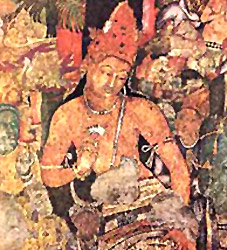 Secular buildings of Gupta period are unfortunately not preserved. But some idea of the early palaces can be formed by the study of sculptural representation at Amaravati and Nagarjunikonda. They were imposing structures several stories high. The types of windows included the arched one with finial, the rectangular one and the latticed. Different kinds of balustrades are also shown. Pilasters and polygonal pillars have fine capitals. The roof was sometimes shaped after the hood of a wagon, sometimes after a simple rectangular hut and sometimes with curvilinear tops and a single towering decoration. Terraces and balconies were sometime open and sometimes covered. There were separate entrances and exits with the arched Tarana decoration. The entrances cut a boundary wall much in the same way as in some of our modern high-class residential buildings.
Secular buildings of Gupta period are unfortunately not preserved. But some idea of the early palaces can be formed by the study of sculptural representation at Amaravati and Nagarjunikonda. They were imposing structures several stories high. The types of windows included the arched one with finial, the rectangular one and the latticed. Different kinds of balustrades are also shown. Pilasters and polygonal pillars have fine capitals. The roof was sometimes shaped after the hood of a wagon, sometimes after a simple rectangular hut and sometimes with curvilinear tops and a single towering decoration. Terraces and balconies were sometime open and sometimes covered. There were separate entrances and exits with the arched Tarana decoration. The entrances cut a boundary wall much in the same way as in some of our modern high-class residential buildings.
The paintings at Ajanta show that sometimes control sized royal pavilions were raised on four cylindrical pillars decorated with golden festoons. The royal seat was placed under the canopy of this audience hall, which was tastefully decorated. Literary evidence further shown that the palace apartments were usually decorated with valuable paintings. Even the houses of rich citizens were furnished with separate picture galleries and concert halls.



















